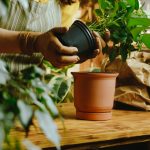Using pots, tubs, or other containers instead of conventional garden beds, container gardening is an easily available and flexible way to cultivate plants in limited, tiny areas. Ideal for city people or those with little outdoor space, this approach lets you produce flowers, herbs, vegetables, even little fruit trees on windowsills, balconies, patios, and roofs. Because of its simplicity and versatility, it’s a great choice for both novice and experienced gardeners. Apart from its utilitarian use, container gardening improves the appearance of homes and offices and introduces vegetation into small living quarters. Anyone may create a rich mini-garden reflecting their own likes and requirements with the correct container, soil, and care. This page looks at what container gardening is, how it’s done, and why it’s a satisfying hobby.
Understanding Container Gardening Basics
Fundamentally, container gardening is the practice of growing plants in individual pots instead than straight from the ground. These containers may be fashioned from clay, ceramic, plastic, metal, wood, or even discarded goods like buckets and pallets. Plant health as well as design tastes depend on the container used. Good drainage is vital, hence most containers need holes at the bottom to stop water from accumulating and compromising roots.
Container gardening requires different kind of soil than conventional gardens. Because they are lighter, well-aerated, better in keeping moisture without getting soggy, potting mixes are chosen. Since potted plants depend only on what is present in the soil mix, fertilizers are usually added to meet nutritional demands. Container environments are constrained, hence effective development depends on constant watering and monitoring.
Container gardening lets one better manage the developing surroundings. Moving the containers will let gardeners control sunshine exposure and customize soil mixtures to meet certain plant requirements. For those trying various plant species or growth conditions in limited area, this makes it very attractive.
Benefits of Container Gardening
Container gardening’s adaptability is one of its clear benefits. Container gardens are movable and flexible unlike conventional gardens that need for plenty of yard area and permanent installation. This makes rearranging plants simpler, maximize sunlight, and move plants inside during severe storms. Renters who want to plant without changing their property will also find it ideal.
Highly space-efficient is also container gardening. Vertical gardening with stacked pots or wall-mounted containers may turn a small balcony or window ledge into a verdant green sanctuary even in the most compact metropolitan settings. Furthermore, in containers where cross-contamination is rare, pests and diseases may be more readily managed than in open soil.
Accessibility is another advantage. Those with limited physical strength or mobility problems may more easily handle a few pots than a big garden. Garding may be done sitting or standing, using containers mounted on shelves or stands, therefore increasing inclusiveness and enjoyment for a larger number of people.
Choosing the Right Plants for Your Containers
Successful container gardening depends on the right plants. Perfect are little types of plants that naturally flourish in restricted root area. Popular selections include herbs like basil, mint, and rosemary; leafy greens like lettuce and spinach; floral plants like petunias and geraniums; and small veggies like cherry tomatoes and peppers.
Think through the light, temperature, and humidity requirements of the plants you have selected. Succulents, for instance, need dry conditions and plenty of sunshine; ferns flourish in shady, damp surroundings. Combining plants with similar needs in one container will save time and guarantee consistent development.
Evergreens or indoor-friendly plants like snake plants, pothos, and peace lilies look great for individuals who year-round appreciate greenery. Seasonal gardeners, on the other hand, could rotate their plants depending on the temperature—growing vivid blooms in spring and summer then moving to tougher greens in colder months. The plant should fit the gardener’s lifestyle, environment, and degree of maintenance capabilities.
Design Tips for Beautiful Container Gardens
Apart from practical purposes, container gardening offers a chance to highlight imagination. Combining many plants, colors, and textures in one or more pots can provide amazing visual appeal. Gardeners have a well-known “thriller, filler, spiller” strategy wherein a tall focus plant (thriller) is flanked by bushy plants (filler), and trailing kinds hanging over the sides.
Choice of containers also greatly affects the general look. Choosing unusual, recycled containers or matching pot colors with the surrounding décor can give a garden character and appeal. Arranging containers on stairs and stands or grouping them according to height creates visual layers and increases the dynamic nature of the arrangement.
Think of themed container gardens—like a kitchen herb garden, a butterfly-attracting flower pot, or a soothing succulent arrangement—for extra effect. To further customize your garden, consider adding lights, trellises, little garden accessories. Container gardening becomes as much an art form as a planting technique with so many adjustable possibilities.
Tips for Maintaining a Healthy Container Garden
Taking care of container plants calls for somewhat more hands-on attention than in conventional gardening. Regular watering is very essential as containers dry up faster—especially in warmer locations or throughout the summer. drip irrigation systems or self-watering pots may help to ease this chore and avoid under- or overwatering.
Another essential element is fertilizer. Regular feeding with liquid or slow-release fertilizers is crucial to maintain good plant development as the nutrients in potting soil diminish over time. Monitoring for symptoms of pests or illnesses is particularly crucial as the small area in containers could lead to speedy spread of problems. React fast as well.
Finally, yearly trimming, deadheading blooms, and soil rejuvenation help your plants to last and look as they should. Replacing crops or rotating them in new soil helps to avoid nutrient depletion and insect accumulation. Your container garden will stay vivid and useful all year long with regular maintenance.
Conclusion
Almost any environment may be used for container gardening, which presents a useful, aesthetically pleasing, and satisfying approach to cultivate plants. Urban gardeners and hobbyists both have grown to love it for its space-saving design, simplicity of upkeep, and limitless creative possibilities. Container gardening lets you connect with nature, even in the middle of the city, whether your project is simple adding vegetation to your interior space, brilliant blossoms for your patio, or fresh herbs for your kitchen.

